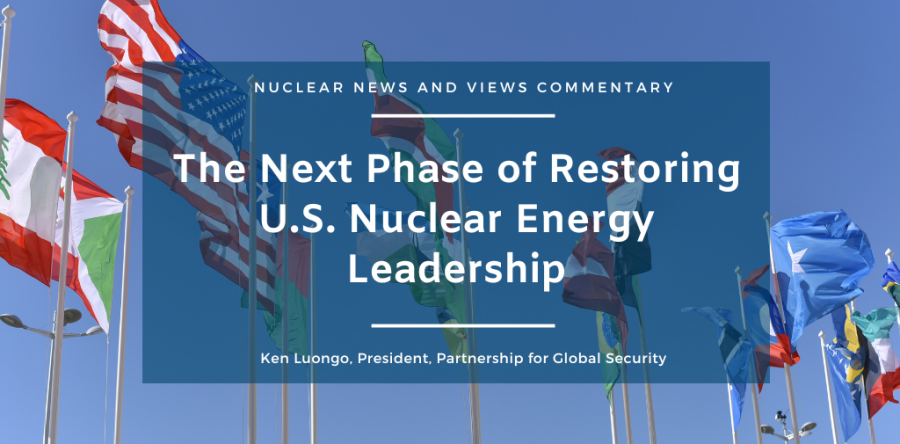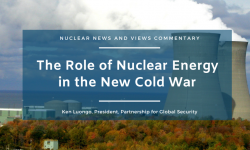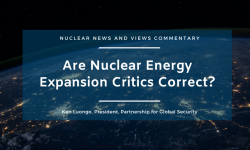Occasionally a new and noteworthy analysis intersects with emerging opportunities, and it produces insights that are valuable and forward-looking.
That is the case with the release of Restoring America's Nuclear Energy Leadership and Exports, a new report authored by Paul Saunders, the President of the Center for the National interest, and published by the Energy Innovation Reform Project.
It makes a number of important recommendations. But, at its core there are two important messages. We need to be thinking about the big global picture in which nuclear energy expansion occurs. And we need to understand and respond to how the global environment has dramatically evolved and construct a policy framework that works in this new world.
As Saunders notes, there is a “gap between institutions and policies…and international realities. As a result, many U.S. approaches no longer suit America’s needs.” That disconnect needs to be addressed.
I had the opportunity to be part of a panel with several other luminaries that discussed the report’s insights. My comments focused on 5 key issues that I believe are important to move to the next phase of restoring American global nuclear energy leadership.
Celebrate Success
The achievements to date have been impressive.
On the technology side, American nuclear reactors are being sought by Central and Eastern European nations. New innovative reactor technologies are under development. And uranium enrichment for HALEU fuel has begun.
Politically, the bipartisan support in the U.S. for nuclear energy is stunning in its breadth and strength given our otherwise extremely polarized political environment. And the funding levels are higher than they’ve been in decades.
Internationally, nuclear energy has now emerged as a consensus solution to climate change as evidenced by the pledge to triple its expansion at COP 28. That is an achievement that was unthinkable even 5 years ago. And, Russian aggression has elevated the importance of global energy security, with nuclear power emerging as a priority objective for those nations that were dependent on Russian fossil fuels.
Energy Geopolitics
While great strides have been made on the climate-nuclear nexus, the work is incomplete on nuclear geopolitics and energy security. And those are key issues for the next phase.
The challenges from Russia and China as competitors and adversaries of the U.S. and its allies are real and growing. That is going to be the case for a long time in this century.
But we have not developed a sound strategy for how to beat the Russian and Chinese advantages in the nuclear export arena. We need to engage with the hard choices that will level the export playing field for U.S. and allied nation technologies as the process shifts from technology development to delivery and deployment.
For example, can the American political system place a price on energy security, global security, and geopolitical influence and use that money to underwrite the significant nuclear project costs. Or can that be done as part of a consortium of allies.
Emerging Markets
Beyond the large reactor competition is the battle for market share for the next-generation of small and advanced reactors. But it doesn’t seem that we have a well-conceived market capture strategy.
It is unclear what our plan is for advanced reactor deployment at-scale once the demonstration phase is over, and the technologies have been proven. And no other country is going to help the U.S. develop this market dominance because our allies want these markets for their companies.
PGS has developed a very large, proprietary, detailed database designed to support U.S. and allied nation nuclear exports. What it makes clear is that every developing economy nation that may be well suited for small nuclear reactor deployment faces significant headwinds in deploying those reactors.
These challenges are often unique to each country and no cookie cutter approach is going to pave the pathway for deployment. Each target country has to be engaged and cultivated on multiple levels.
Capacity building seems to be the primary U.S. response to market development among new countries interested in smaller nuclear reactors. But it is not enough. And the metrics need to be more significant than numbers of engagements.
We need new approaches to getting American reactors into developing economy nations and ensuring they are operated safety. That may require supporting reactor developers and operators to play a larger role in-country.
Nuclear Governance
Similarly, the global governance system for these new reactors is going to be different than the one we have now, particularly for nuclear safeguards, security, and the prevention of proliferation.
We’ve barely scratched the surface of what those changes are and the funding for the development of this policy framework is minuscule, despite the good collaboration among the U.S. and allies on licensing and safety issues.
If the U.S. and its allies don’t write and advance this governance evolution at the IAEA and in other bilateral and international fora, it leaves the field open to Russia and China.
And we can’t allow that to happen in a world where we may double or more the number of deployed reactors over this century and when powerful advanced technologies and nuclear energy are rapidly fusing.
Ecosystem Expansion
Finally, while we have a well-financed, technology-centric approach to nuclear power, there is a much lower priority and funding profile for the corollary issues that will form the ecosystem in which it can be successful.
These include policy development, international market cultivation, and financing plans that are necessary for the durable success of the U.S. as a nuclear energy leader in this century.
Further, there is a need to create, integrate, and sustain new forms of multi-disciplinary nuclear nexus expertise from the university through the professional levels that can respond effectively to a fractious, dangerous, and ultra-competitive world where nuclear power is a central component.
We cannot fail in this mission. I don’t believe there will be a second chance for American nuclear energy leadership if we can’t push past our current successes and build an even stronger foundation for progress in the next phase and beyond.
Ken Luongo, President, Partnership for Global Security





